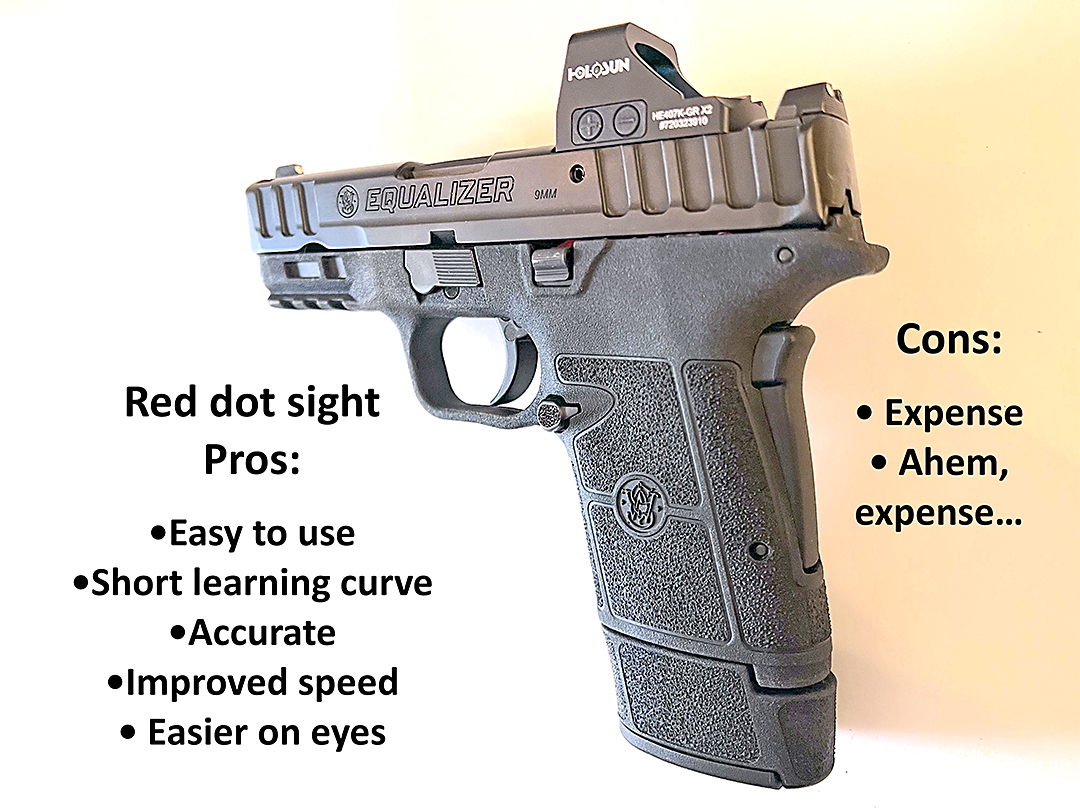HOW DO YOU ALIGN YOUR SIGHTS?

By MARJ LAW

Want to hit the target with your semi-automatic handgun?
First, you need to learn to align your sights.
Two sights are most common.
1) When you’re about to shoot (and of course, aiming in a safe direction), the sight furthest away from you at the end of your barrel is the front sight. The rear sight is the one closest to your body. In the 3-dot system, 2 dots are near you in the rear and 1 dot is at the front of your handgun.
2) Another popular sight system is a 2 dot. The front sight is a dot and the rear sight near you is only one dot.
Basically, when you have the 3-dot system, you line up front and rear sights until all 3 dots form one straight line. Aim at the X-ring right over that middle dot of that line. That’s the front sight. Upon pulling the trigger, your bullet should hit the target where you want it.
Did it work? No? Where did that bullet go? And, if you don’t know the answer to this, is the problem your aim or do the sights need adjusting?
To find out, you can lock your gun into a gun rest. The gun rest holds the gun in a stable position when you pull the trigger.
Okay. Line up your sights. Do you see where the bullet hit this time? Oh dear. Still not near that X-ring? Over to the left and below that X-ring?
All is not lost. Most of the time, you can adjust your rear sight so the bullet hits where you want it to. Moving that rear sight right or left is called “windage.” Moving it up or down is called “elevation.”
In most cases, you’ll see 2 slots somewhere on your sight. A very small flat-head screwdriver can turn these slots. One slot controls elevation while the other slot controls windage. Since you have shot to the left, take your screwdriver and move the windage slot to the right. Shoot again. Did it work? Is the hole in the target just below the X-ring? If not, continue to adjust, a little at a time until you are below the X. That’s windage!
Now for elevation. Find the other slot, and move it a small bit. Continue until holes made by your bullets finally hit the x. You did it! You’ve controlled your windage and elevation.
Take your gun out of the gun rest. Aim and shoot. At this point, if you don’t hit the X-ring, you know there’s not a problem with your gun. Darn. Time to examine your grip, stance and technique.
The 2-dot sight system involves lining your front sight over your rear sight like a figure 8. Once they are aligned, you want your bullet to hit the target directly above your front (top) sight. Again, look for slots you can manipulate with a screwdriver to adjust elevation and windage. Use a rest to hold your gun securely.
Once aligned, take your gun out of the rest and shoot freehand. If the gun was aligned in the rest, but now your target acquisition is off, then unfortunately the problem is you. Check to see if you have a good grip, stance, and technique.
Some semi-automatics have sights that are not adjustable. If you find it difficult to hit a target accurately, place the gun in a rest. Shoot it from the rest to see where the bullet hits. You may find that your bullet pulls in one direction or another.
In this case, practice is your friend. You can learn to compensate. If your gun, even clamped down, hits a bit low and to the left, then you can learn to shoot higher and to the right. It’s all about knowing your gun. If your life is at stake, you need to know your gun and compensate if you have to.
And what’s this about mounting a red dot sight on your handgun?
Is using a red dot cheating?
Red dots are fun. You may have a place on the top of the slide where you can mount a red dot sight.
And why would you want to spend a couple hundred or so more to mount a new sight when you have perfectly good ones?
Because red dot sights are fun. They are super easy to use for a beginner. No longer do you have to bring up your gun and take the time to line up your front and rear sights before you can shoot. No big learning curve any more. And if you’re a seasoned hunter? Now you can sight on your prey faster and more accurately.
Instead of lining up sights, you look at your target. Bring up your arms, and you’ll see a red dot on the target. That’s it. You’ve acquired your sights in one swift move!
Move your head? If you used your old sights, you’d have lost your target. With the red dot, your head position behind the sight won’t affect your accuracy. The dot isn’t going anywhere.
And remember that one-eyed squint? Forget it. Open both eyes and look where you want to shoot. Bring your arms up, and there’s your dot! Or maybe the dot is green. I like the green ones because green seems crisper than red to me. If they’re green, they are still called red dot sights. Go figure.
Batteries? Yes, red dots use batteries. Most batteries are very long-lived. But other red dot sights turn on when you pick the gun up and they turn off a few minutes after you’re done shooting. Neat, huh?
More of an expense when you have sights already on your gun? Yes, they sure are. Do you want improved speed and accuracy? Yes, you do!
Mr. Bad breaks in your house? Grab your gun and plant that red dot on him.
Yes, you do have to unlearn the way you’ve trained to align your old sights.
But it won’t take long at all to enjoy shooting with a red dot sight.
Marj Law is the former director of Keep Wakulla County Beautiful who has become an avid shooter in retirement.
